exhibiting excellence
Two young alumnae launch their careers at the Metropolitan Museum of Art
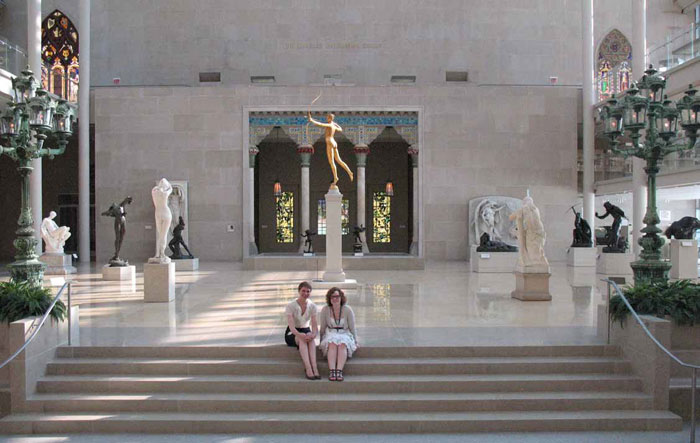
In the Metropolitan Museum’s Charles Engelhard Court, Katie Steiner (left) and Patricia Edmonson are surrounded by 19th-century American sculptures. Behind them is a four-columned loggia that Louis Comfort Tiffany designed for Laurelton Hall, his country estate in Oyster Bay on Long Island.
Everyone knows the old joke about how to get to Carnegie Hall: “Practice, practice, practice.” But how do you get to the Metropolitan Museum of Art?
Patricia Edmonson '06 and Katie Lynn Steiner '06 found the answer to that question. Two years after graduating with honors in art history from Case Western Reserve, they were both hired by the country's premier art museum. Edmonson, who began as an intern in American decorative arts, is now a research assistant at the Met’s Costume Institute. Steiner has been a research assistant in the department of American paintings and sculpture since joining the museum in 2008.
“It’s really extraordinary to have the two of them there,” says Jenifer Neils, Ruth Coulter Heede Professor of Art History, who taught them both and was Steiner's thesis advisor. While the department has long known that its best students can compete with their counterparts from any other university, no one expected two graduates from the same class to land their first jobs at the Met.
"These are the most highly sought-after positions in the museum world," Neils says. "Katie and Patty are being trained under top curators, and they will have an incredible credential." But that isn’t the only reason she is delighted for them.
“The Met is a universal museum; it collects in all areas," she explains. "And because it’s so huge and has so many departments, the staff can focus on their particular areas of interest. In a smaller museum, you have to be a jack-of-all-trades. The beautiful thing for Katie and Patty is that they can use their expertise in their chosen fields—in the case of Katie, in American art; in the case of Patty, in fashion and decorative arts.”
Through its joint program with the Cleveland Museum of Art (CMA), Case Western Reserve’s art history department gave Edmonson and Steiner an insider’s view of the museum profession while they were still undergraduates. They took classes with CMA curators and studied objects from the collection. And with this background, they were accepted to two of the nation’s most selective master’s programs, both of which are also affiliated with distinguished museums.
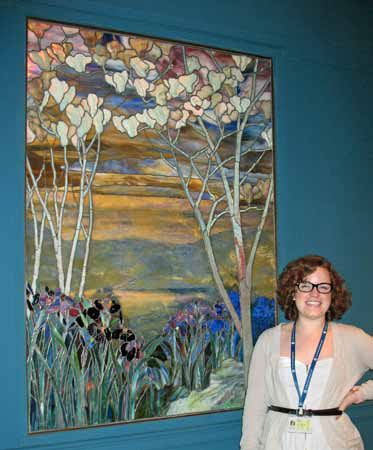
As a result, Neils says, Edmonson and Steiner became familiar with “the whole process of acquiring, displaying and elucidating works of art.” Such experience is attractive to institutions like the Met. It is also increasingly rare, since “the trend in art history is very theoretical, and not so object oriented.” For these alumnae, then, earning a degree from Case Western Reserve turned out to be the ideal preparation for their surprising journey.
Transported by Interiors
A native Clevelander, Edmonson says that museums have always been a family preoccupation. Her father, James M. Edmonson, is chief curator of the Dittrick Medical History Center and Museum at CWRU. Her mother, Christine Edmonson, is a reference librarian at the CMA. As a child, Edmonson used to wander through the Dittrick on evenings when her parents worked late. Her favorite displays were the period rooms showing how a doctor's office or a pharmacy looked in the late 19th or early 20th century. To her, these rooms had a theatrical quality. “I loved the whole atmosphere, the otherworldliness,” she says. “I felt transported by interiors.”
Early in her undergraduate career, Edmonson decided to focus on American material culture, which encompasses everything from fashion to furniture to the apothecary bottles in her father’s museum. She pursued her interests through two internships with University Circle institutions.
At the CMA, she helped William Robinson, Ph.D. ’88, curator of modern European art, edit the catalogue for Barcelona and Modernity, a loan exhibition that included decorative arts from the Catalan region of Spain. At the Western Reserve Historical Society, she worked on costume displays for Millionaires’ Row: The Legacy of Euclid Avenue, an exhibition devoted to Cleveland industrialists and philanthropists from the Gilded Age until the Great Depression. The show included dresses by the Spanish designer Mariano Fortuny, who became the subject of Edmonson’s honors thesis.
Edmonson pays tribute to her advisor, associate professor Anne Helmreich, for allowing her to bypass more conventional topics and write about 20th-century fashion instead. But Helmreich remembers being genuinely fascinated by Edmonson’s project. Fortuny’s dresses, she points out, were “very radical in their day. Patty looked at his inventiveness as a designer, but she also showed how modern he was in terms of technology and his business sense.”
Helmreich adds, “It was the perfect project for her, because it came out of the internship she had done at the historical society. She had gotten to handle the dresses, to see them for herself. And because she was so familiar with the objects, she was able to ask really interesting questions.”
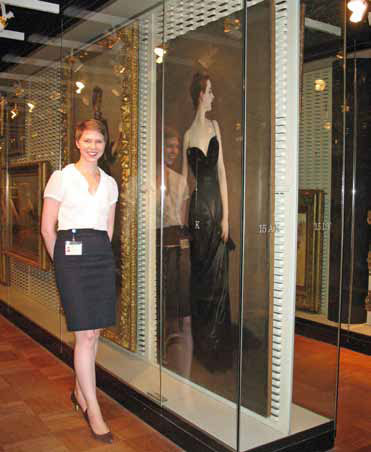
As if to pesent a lesson in contrasting styles, Katie Steiner visits John Singer Sargent's Madame X (1883-84) at the Met's Henry R. Luce Center for the Study of American Art.
After completing her bachelor’s degree, Edmonson went on to the Winterthur Program in American Material Culture at the University of Delaware. One of only 10 students admitted to the program that year, she continued to explore the relationship between material culture and commerce in the early 20th century. For her master’s thesis, she retraced the history of the furnishings trade in New York in the 1920s. Her project blended archival research with the study of objects in the Henry Francis du Pont Winterthur Museum.
In the spring of 2008, as she was finishing her thesis, Edmonson was chosen as the Tiffany & Co. Foundation Curatorial Intern in American Decorative Arts at the Metropolitan Museum. A few weeks later, Steiner called to tell her that she, too, had just accepted a position at the Met.
A Series of Mentors
Compared to Edmonson, Steiner had a more conventional introduction to museums. She grew up in South Euclid and remembers taking field trips to University Circle. But then, as a high school senior, she became a CMA intern and went to work for Henry Adams, then the museum’s curator of American art. Like many of his colleagues, Adams also taught at CWRU, where he’s now a faculty member, and he invited Steiner to audit a graduate seminar he was leading that spring. “I couldn’t really participate; I didn’t have the background,” she recalls. “But it was so interesting to meet the graduate students and to hear from other curators and museum administrators who spoke to the class.”
The next fall, when Steiner enrolled at Case Western Reserve, she took Adams’s introductory course in American art and decided to major in art history. (Later, she added English and became a double major.) While American painting remained one of her primary areas of interest, Steiner also studied African art with CMA curator Constantine Petridis and northern Renaissance art with associate professor Catherine Scallen. As a recipient of an Experiential Learning Fellowship, she traveled to the French city of Colmar for an independent research project on the influence of religious drama on Renaissance prints, manuscripts and paintings. Finally, in her honors thesis, she wrote about the CMA’s acquisition of a life-size bronze figure, Apollo the Lizard-Slayer, that some scholars have attributed to the ancient Greek sculptor Praxiteles.
When Steiner was just starting to think about graduate school, Scallen recommended the master’s program at Williams College, which she had attended before earning her Ph.D. at Princeton. To Steiner, Williams looked like an intimidating place; she sensed that it was a program for Ivy League types. But with Scallen’s encouragement, she applied and was accepted.
As a graduate student, Steiner worked at the Sterling and Francine Clark Art Institute, where her faculty advisor was curator of prints, drawings and photographs. The Clark had just been given an important collection of 18th- and 19th-century British paintings and works on paper, including sketches of Salisbury Cathedral by the landscape artist John Constable. Steiner wrote about these sketches for her master’s thesis.
Then one day, the associate director of Steiner’s graduate program called her in and said, “My colleague Barbara Weinberg, the curator of American paintings and sculpture at the Met, is looking for a research assistant.” Was this something she would be interested in?
Unlike some of her fellow students, Steiner didn’t have her heart set on finding a job in New York, let alone at the Metropolitan Museum. “Honestly,” she says, “I would have been just as happy to come back to Cleveland, if a position had been available at the Cleveland Museum of Art. But this is where the opening was. And yes, I feel lucky that it turned out the way it did.”
From Face Jugs to Stemware
For both Edmonson and Steiner, the timing of their arrival at the Met could not have been better. The museum was in the midst of a four-year, $100 million renovation of its American Wing. For the first time in 30 years, curators were rethinking how they exhibited the permanent collections of American paintings, sculpture and decorative arts.
Edmonson quickly became involved in the planning for reopening the Charles Engelhard Court, an immense glass pavilion whose balcony-level galleries are filled with American ceramics, glass, silver, pewter and jewelry. In one of her favorite projects, she was asked to research a brown stoneware jug, origins unknown, “bearing a lively, modeled face.” She had read about jugs like this before. Hunting through back issues of Ceramics in America, she found the article she remembered and wrote to the author. He confirmed that the Met’s face jug had come from the John Miles Pottery in Edgefield, South Carolina, a firm that, beginning in the 1860s, employed some of the first African-American craftsmen to produce such objects. “The staring eyes and gaping mouth are typical features of face jugs made in the second half of the 19th century,” Edmonson eventually wrote in her exhibition label. “This example is missing its teeth and lips—a common loss, sometimes occurring as early as the firing stage.”
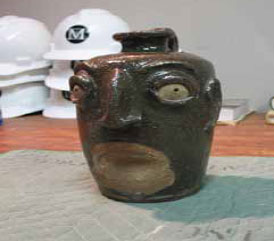
While preparing for the reinstallation of the Met's permanent exhibition of American decorative arts, Patricia Edmonson filled in the history of this 19th-century face jug.
Edmonson also had a part in the reinstallation of the American period rooms, which represent domestic architecture and interior design from the colonial era to the early 20th century. Her research focused on a dining parlor from a Baltimore row house built around 1810. The room’s architectural elements had been taken directly from the house, but the curators assembled the furnishings from several 19th-century sources. Edmonson helped select the glassware. It came from Pellatt & Green, the premier London glasshouse of the day; the original buyer commissioned it for his daughter and son-in-law, who lived in Albany, New York. On a computer touch screen in the Baltimore Room, you can see the bill of sale, dated September 5, 1818. Edmonson notes that for a table service from this period, such documentation is extremely rare.
The labels that Edmonson wrote as an intern went on view when the Engelhard Court and the period rooms reopened in May 2009. “I feel lucky to have contributed to the museum in such a tangible way,” she says. She also valued the chance to observe the months of planning and decision making that went into the refashioning of the permanent exhibitions.
“I was included in discussions on label design, the editorial process and the installation of objects in their cases on the balcony,” Edmonson recalls. The experience reminded her that in museum work, there is no such thing as an insignificant detail.
Paintings of Everyday Life
Steiner has helped to convey that same lesson to the Met’s audiences. Last fall, she began giving public talks and tours for visitors to a major loan exhibition, American Stories: Paintings of Everyday Life, 1765-1915. Steiner had been involved in the final preparations for the show, which featured works from more than 50 public and private collections. She was on hand when each painting arrived and was unpacked from its crate. She took part in deliberations about the arrangement of the paintings and the choice of wall colors. And once the exhibition opened, she drew on those experiences as she led tour groups through the galleries.
In addition to giving talks, Steiner wrote an American Stories blog for the museum’s web site. Her brief essays are remarkable for their genial erudition. While attending carefully to the details of individual canvases, Steiner related the paintings to larger developments in American social and cultural history. And in several posts, she extended her discussion to works that weren’t even part of the exhibition.
For an essay on 19th-century printmaking, for instance, Steiner uploaded images of mezzotints and woodcuts that had been engraved after paintings in American Stories. Such prints, she noted, circulated in England and France as well as in the United States; they owed much of their popularity to European curiosity about the American way of life.
Steiner’s main purpose in writing the blog was to make the exhibition accessible to her readers. She encouraged them to visit the show, or return for a second look, by emphasizing its relevance to their own everyday lives. Steiner observed Thanksgiving with a post on depictions of food in American Stories; the week before Christmas, she wrote about images of shopping and conspicuous consumption. When PBS broadcast Ken Burns’s documentary about the national park system, Steiner responded with an essay on paintings of figures in unspoiled American landscapes.
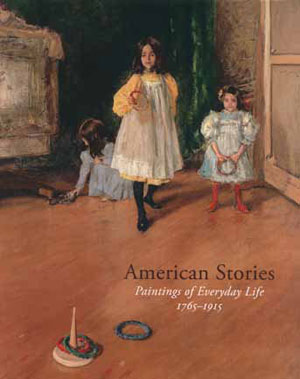
In addition to writing the exhibition blog for American Stories, Katie Steiner helped edit the catalogue.
The Metropolitan Museum has hosted blogs for other special exhibitions, but until now, they were all written by curators. Steiner’s blog for American Stories was as scholarly as its predecessors, but it also took the genre in a new direction.
Showing the Way
Having left the American Wing for the Costume Institute, Edmonson is busier than ever. In December 2008, the Brooklyn Museum transferred its immense costume collection—23,500 objects in all—to the Met. Edmonson is part of a team integrating these objects into the institute’s exhibitions, publications and educational programs.
When she thinks back to her early months at the museum, Edmonson pauses over a private memory: the music she listened to on her iPod as she walked to work. “It’s a little embarrassing to admit,” she says, “but when I knew I was getting close, I would put on a happy song. Then the Met would appear in my sight line, and I would remind myself how cool it was to be there.” If tourists stopped her and asked how to get to the Metropolitan Museum, she might not have heard them at first. But once she did, she was able to show them the way.
